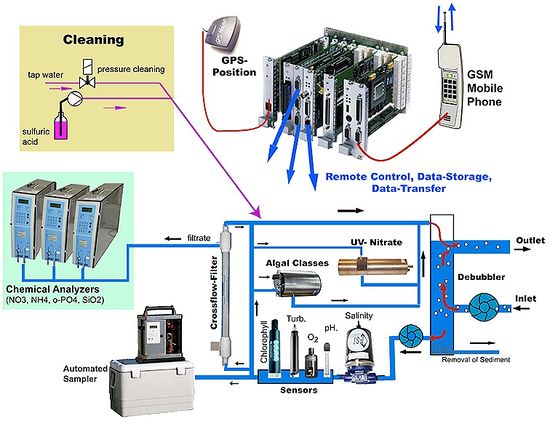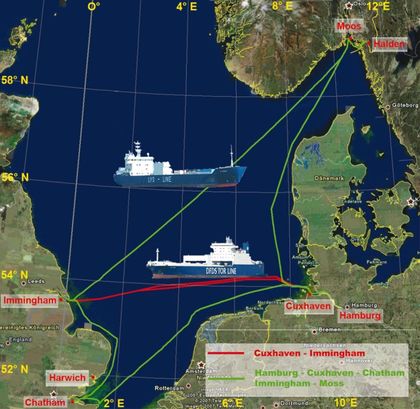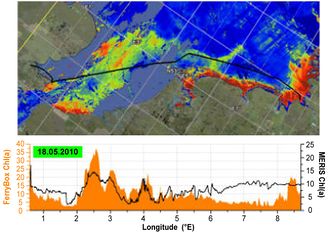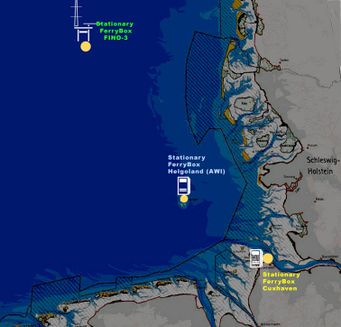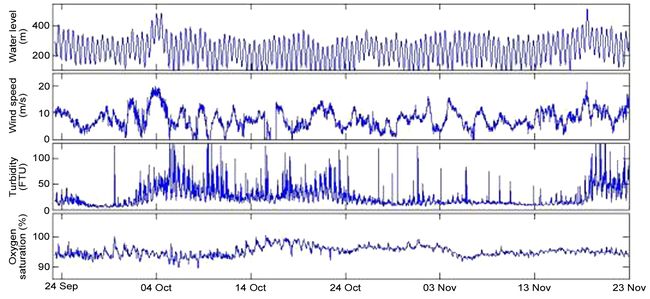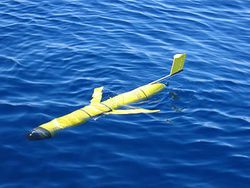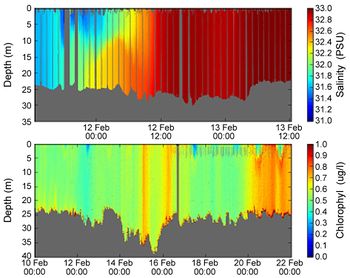Difference between revisions of "Coastal observation systems"
(→First Results) |
(→First Results) |
||
| Line 151: | Line 151: | ||
<br> | <br> | ||
<p> | <p> | ||
| − | + | <br style="clear:both;"/> | |
| + | == Surveys with Research Vessels == | ||
Revision as of 12:26, 30 August 2012
Contents
The need for observations
There are a series of objectives why we need to have observational data: to control the outcome of (governmental) monitoring programmes, the obtain data for modelling exercises and to enable scientific analyses of field data to improve our understanding of the marine environment, e.g. to enable assessments of the environmental quality and long term changes.
To observe our marine environment several options are nowadays available: FerryBoxes, Poles in shallow waters like the Wadden Sea, Gliders, regular ship cruises for vertical resolution of parameters, wave rider buoys, shore based radar like HF and XF, and remote sensing from satellites. A combination of different approaches enables coverage on different time and spatial scales. Several of these observational techniques will be presented through examples of actual measurements. Examples are taken from the COSYNA integrated observation system developed by HZG together with other German research institutes during the last years.
FerryBox
Transectional and stationary in situ observations
The FerryBox is an automated measuring system used for the measurement of physical and biogeochemical parameters in surface waters. It is mounted on ‘ships of opportunity’, such as ferries or container ships, on their regular routes across the North Sea or on shore-based installations (Helgoland Island, Cuxhaven, and FINO3). Water is pumped from a subsurface inlet into the measuring circuit of multiple sensors (see Diagram)). An important feature is the regular automated cleaning and antifouling procedure of the box. All processes can be controlled remotely via the telemetry line from land. Data are transmitted and made available after each transect via the Internet. Due to the automated biogeochemical instrumentation of the FerryBoxes the regular transects give detailed insights into the processes and are a main source for data assimilation into models.
| Schematic design of the FerryBox flow-through and data system with special features for unattended operation (automatic cleaning system). |
Parameters measured are a.o. water temperature, conductivity, turbidity, oxygen, pH, and chlorophyll-a-fluorescence. Water samples for further lab analysis are taken. On some routes measured additionally are: Algal classes and nutrients (ammonia, nitrite/nitrate, o-phosphate, silicate). In the near future sensors for pCO2, alkalinity, a flow-cytometer and an instrument to measure geneprobes to detect specific species can be installed in some FerryBoxes.
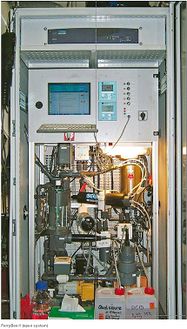
|
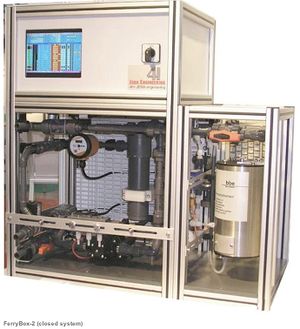
|
| Ferry Box (open system) | Ferry Box (closed system) |
| Pictures of commercial available FerryBoxes | |
Water quality data of surface waters on 3 ship routes in a high frequency (daily, 2-daily, weekly - depending on route). Due to some long-distance routes to England and Norway these data are the link between the German Bight and the North Sea.
| Current FerryBox transects in the southern North Sea operated by HZG: Route Cuxhaven - Immingham: RoRo-ship TorDania, Route Gemany - England - Norway: cargo ship LysBris. |
The FerryBox technology developed by HZG works so well - especially due to the integrated anti-fouling system - that it is used not only on ships but as well at any station that has enough power to run the necessary pumps. Therefore, these 'stationary FerryBox systems' have been installed in the stations 'Cuxhaven' and 'Fino-3'. Our partner AWI installed one FerryBox on their shore station at Helgoland. The design and the parameters are the same as on the ship-borne FerryBox systems. The pictures bellow show salinity data from a transect in the southern North Sea between Germany (Cuxhaven) and the UK (Immingham) during the period from March till November 2008 and a graph showing a single transect and the concomitant remote sensing picture of the southern North Sea for the parameter chlorophyll-a.
| Salinity data from a transect in the southern North Sea between Germany (Cuxhaven) and the UK (Immingham) from March till November 2008. |
Single transect and the concomitant remote sensing picture of chlorophyll-a in the southern North Sea. |
Apart from FerryBoxes on board ships of opportunity the possibility exists to install FerryBoxes stationery at selected locations. Currently installations at three locations along the river Elbe (Cuxhaven), on the island of Helgoland and on a research platform (FINO-3) are in operation (see map).
| Map indicationg the locations where FerryBoxes are installed with yellow dots. |
Stationary in situ Observations
Wadden Sea Poles
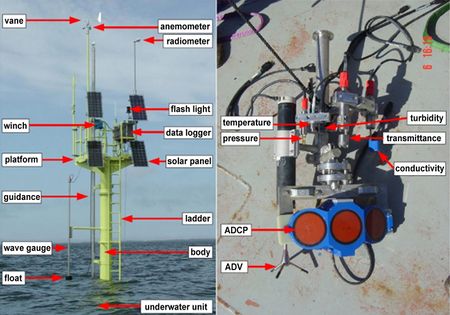
|
| A picture of a Wadden Sea Pole the different censors are indicated. |
High-frequent water quality data are a prerequisite for an assessment of the substance exchange between North Sea and Wadden Sea.
Parameters measured are pressure (depth), water temperature, conductivity, current velocity/direction, turbidity, chlorophyll-a-fluorescence, photosynthetic active radiation, pH-value, oxygen, and meteorology (pressure, temperature, wind speed, humidity, irradiation and precipitation). An example of such as complete pole is shown in the diagram.
The continuously operating reference network of COSYNA is built from fixed platforms producing high-resolution time series of meteorological, oceanographic and water quality parameters. They yield insights into the system’s variability on time scales ranging from seconds to years. In the German Bight, existing and planned off-shore platforms, e.g., FINO3 and wind energy installations will provide power and broadband capacities to operate FerryBoxes and wave radars. Smaller, self-contained poles in the Wadden Sea (see figure above) and the mouth of the Elbe record data through which to study the exchange of energy and matter between the shallow, intertidal near-coast basins and the German Bight.
In the shallow areas of the Wadden Sea poles enable the automated measurement of different parameters. Energy supply is by solar panels. All data are transmitted to shore.
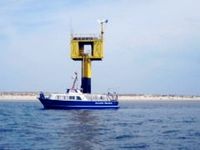
|
| The Spiekeroog Pole |
Spiekeroog Pole
Since autumn 2002, the ICBM, University of Oldenburg, has been running the research platform Spiekeroog. In the framework of COSYNA the station is modernized by applying new technical concepts and new instruments. The complete update of the research platform should be finished at the end of the year 2012.
Exemplary results
The figure bellow depicts a typical high-resolution 10 min time series, measured in the Hörnum Deep, south of Sylt Island. From top to bottom, data on water level, wind speed, turbidity and oxygen saturation are shown for two months. One can see that high wind speeds, e.g., during 4 October, 2009 and 19 November, 2009, influenced not only the water level (inflow of North Sea water into the Hörnum Deep), but also led to higher erosion rates that are mirrored by an increase in turbidity.
| Typical high-resolution 10 min time series, measured in the Hörnum Deep. |
Gliders
| The underwater glider |
The underwater glider, or glider in short, is an autonomous underwater vehicle. It works buoyancy driven and is extremely energy efficient.
The underwater glider, or glider in short, is a relatively new measurement platform, and originally developed as a low-cost, long-endurance device for observing the oceans. Being a host for a multitude of sensors, such as CTD, optical backscatter, and fluorescence sensors, gliders can be programmed to follow set way-points. Depending on the sensor payload and battery type, glider missions may last from a couple of weeks to a couple of months. During the mission, the glider pilot can adjust sampling strategies, way-points, etc. from behind his/her desk using a satellite link to communicate with the glider. Concurrently, whilst in operation, (a subset of the) data can be sent to a land-based server via a satellite link, providing scientists with near-real time data.
Concept of operation
In contrast to conventional underwater vehicles, the glider has no propeller. Instead, the glider has a buoyancy engine, which allows the glider to control its buoyancy by +/- 250 g. Consequently, the glider can attain a vertical motion up or down, depending on its buoyancy. A pair of wings converts a part of the vertical velocity into forward motion. As a result, the glider profiles the water column in a saw-tooth manner. Its low cruising speed of about 40 cm/s makes the glider extremely efficient and operates at about 1-2 Watts, giving the glider the unique endurance. A glider at the surface is shown above. It is envisioned to include glider technology in the COSYNA observatory. Due to the adverse conditions in the North Sea (strong currents, high-volume ship traffic), first a pilot project will be conducted. A first test has recently been completed. Deployed from Helgoland, HZG's first glider Amadeus flew a 15 day mission during the second half of February 2011, travelling over 300 km, and enduring effortlessly a more or less continuous winter storm.
| Data collected using the glider during a 15 day test. |
First Results
Data collected during this mission are shown in the figure below. The upper panel shows salinity, computed from the CTD's conductivity, temperature and pressure for a two-day period around 12 February. Due to strong mixing as a result from currents and windforcing and lack of a thermocline (as it was winter), most of the time the water column is well-mixed. Around 12 February, however, the glider crossed a front. The top panel shows the detailed recordings of the horizontal and vertical gradients in salinity at the location of the front. The bottom panel shows the concentrations of chlorophyll-a for the whole mission period. Because of the winter season, the concentrations are low. During the course of the mission, some variability in chlorophyll is observed. Further analysis should distinguish between geographical and temporal effects.
Surveys with Research Vessels
Please note that others may also have edited the contents of this article.
|
